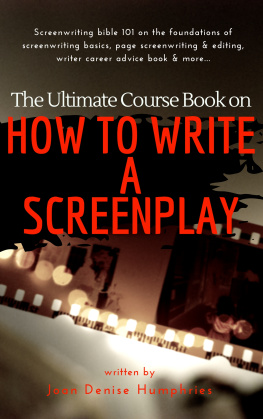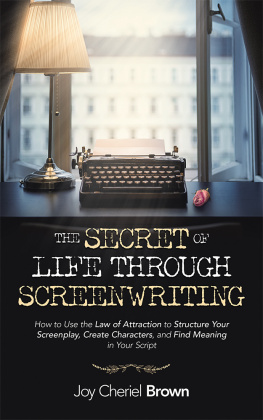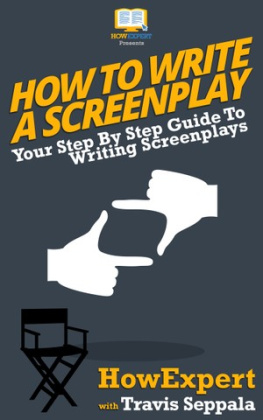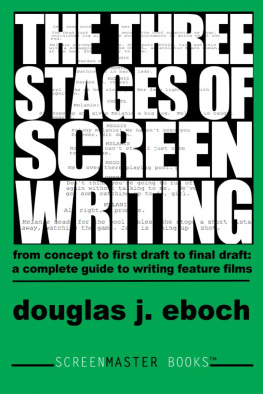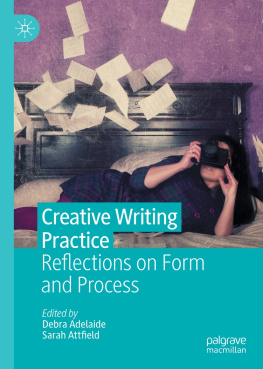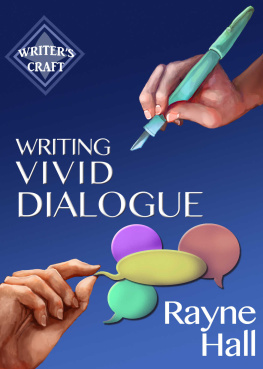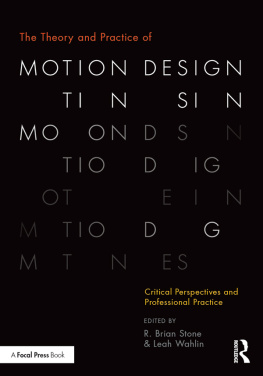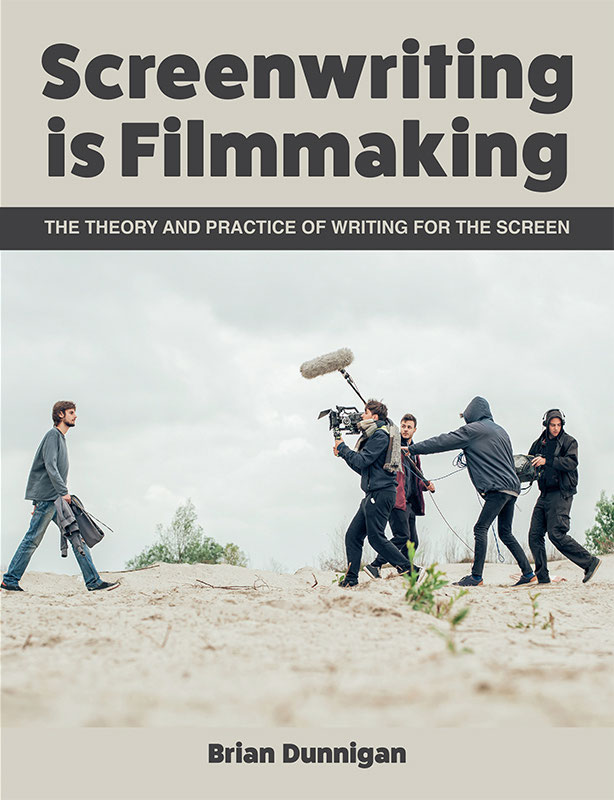Screenwriting
is Filmmaking
Brian Dunnigan offers a wealth of experience and knowledge in the field of screenwriting.
Robyn Slovo
In the beginning was The Word. Brian Dunnigan has brilliantly encapsulated the profound dependency all filmmaking has on the ideas that arise from a well written screenplay. Screenwriting is Filmmaking is an invaluable resource for anyone facing the task of making a film. I cannot commend it enough.
Iain Smith
Screenwriting is Filmmaking is the book I have been looking for! Uniquely tracing the origins of screenwriting up to present day, it gives an unsurpassed context for contemporary film writing. Whether a skilled professional or aspiring student, you will find this an invaluable tool in developing your script writing skills and turning your ideas into a screenplay.
Sandy Lieberson
Often a screenplay is thought of as an ends to a means. It is neither an image nor is it a piece of literature. Yet it is imperative to the success of a film. In Screenwriting is Brian Dunnigan helps shed light on the symbiotic relationship between the two. Brian has a profound understanding of the craft, and his emphasis on story and character is essential reading for anyone wanting to uncover the beating heart of their own screenplay.
Gonzalo Maza
Screenwriting
is Filmmaking
THE THEORY AND PRACTICE OF WRITING FOR THE SCREEN
Brian Dunnigan
First published in 2019 by
The Crowood Press Ltd
Ramsbury, Marlborough
Wiltshire SN8 2HR
This e-book first published in 2019
www.crowood.com
Brian Dunnigan 2019
All rights reserved. This e-book is copyright material and must not be copied, reproduced, transferred, distributed, leased, licensed or publicly performed or used in any way except as specifically permitted in writing by the publishers, as allowed under the terms and conditions under which it was purchased or as strictly permitted by applicable copyright law. Any unauthorised distribution or use of this text may be a direct infringement of the authors and publishers rights, and those responsible may be liable in law accordingly.
British Library Cataloguing-in-Publication Data
A catalogue record for this book is available from the British Library.
ISBN 78500
CONTENTS
CONTENTS
CONTENTS
CONTENTS
CONTENTS
CONTENTS CONTENTS CONTENTS
CONTENTS
CONTENTS
CONTENTS CONTENTS CONTENTS
CONTENTS CONTENTS CONTENTS CONTENTS
CONTENTS CONTENTS CONTENTS CONTENTS
CONTENTS
CONTENTS CONTENTS CONTENTS
CONTENTS
CONTENTS
CONTENTS
CONTENTS
CONTENTS CONTENTS
CONTENTS
ACKNOWLEDGEMENTS
This book is based on my thirty years of writing, film-making, teaching and running workshops in the UK and internationally on screenwriting and what it means to be a screenwriter.
My first appreciation must go to the staff and students at the London Film School (LFS) for sharing their knowledge and passion for cinema, and in particular to Alan Bernstein, Ben Gibson, Barry Salt, Colin Tucker, Simon Louvish, Archie Tait, Les Blair and Howard Thompson for their specialist insights, and to Moshe Nitzani, Chi Yu, Umpha Koroma, Shirley Streete-Barath and Annette Streete for their unstinting support.
I also want to thank my colleagues on the MA Screenwriting programme at LFS. While I designed and launched the MA, it was the contribution of many, including Ellis Freeman, Philip Palmer, Roger Hyams, Margaret Glover, Jeremy Page, Jane Wittekind, Giles Borg, Katie Rae, John Sibley, Gillian Harrison, Amanda Schiff, Sue Austen, Richard Kwietniowski, Jon Gilbert, Jonathan Hourigan and Sophia Wellington, which made the course such a success and from whom I have learned so much.
Thanks also to the many professional friends and visiting tutors on the MA at LFS, all of whom so generously shared their insights on screenwriting and film-making with the students and myself; these have enriched the book, while all responsibility for any mistakes or faults rests with me.
Richard Raskin encouraged me to write on the short film and published my first work in the Danish Journal of Film
The Screenwriting Research Network gave me the opportunity to develop my ideas in a series of conference papers.
I am grateful to Jonathan Hourigan, Sophia Wellington and Jon Gilbert who read an early draft of the book and gave me useful comments.
Thank you to Caroline Penn for finding great film stills and illustrations at affordable prices!
My thanks to the staff of La Duchesse, the Yellow Warbler and the Green Room, the coffee houses in Stoke Newington, where much of the book was written. To my children, Madeleine and Pete, and especially to Louisa for several late nights of copy editing and collating. And, finally, to my wife Hetty Einzig, for her insightful comments and critical edits, without whom this book would not have been possible.
Brian Dunnigan
INTRODUCTION
The aim of this book is to illuminate the historical and theoretical context of current screenwriting practice and to emphasize the place of the screenplay in the process of film-making.
The book traces the development of the classical narrative and dramatic tradition from its roots in oral storytelling and early Greek theatre, through nineteenth-century theatrical forms to the emergence of a distinctive cinematic language. It discusses the principles, concepts and vocabulary of the practice of film-making in relation to case studies of specific screenplays and films.
Analyses are drawn from a wide range of classic and contemporary films, while the book also offers a wealth of practical insights, exercises and examples that you can apply to the writing of a short film or feature screenplay. The conceptual analysis is always linked back to the context of screenwriting and the development of the writers personal voice.
At all times the book encourages the student to dig deeper into the background of conventional technique and its relationship to audience engagement, while highlighting alternative approaches and encouraging the reading and analysis of screenplays as complementary to the practical work.
Each chapter builds toward a conceptual framework that can be used as a basis for writing a short or feature film screenplay. The topics discussed are:
Stories and Narrative The narrative impulse is linked to our need for order and meaning, empathy and cooperation, and our interest in risk and adventure, movement, action, information and knowledge. Simple narrative patterns are analysed with reference to fairy tales, detective stories and the short film. Exercises encourage the exploration of personal experience and memory as the basis for film stories.
Creativity Writing is a creative act, a form of play, a powerful experience of something other within oneself. This chapter emphasizes exploration, discovery and making something new over rules and formulas, while finding originality in the personal. At the same time, it focuses on the importance of dialogue with other people, giving and taking feedback, listening and paying attention. Screenwriting is a collaborative process.



